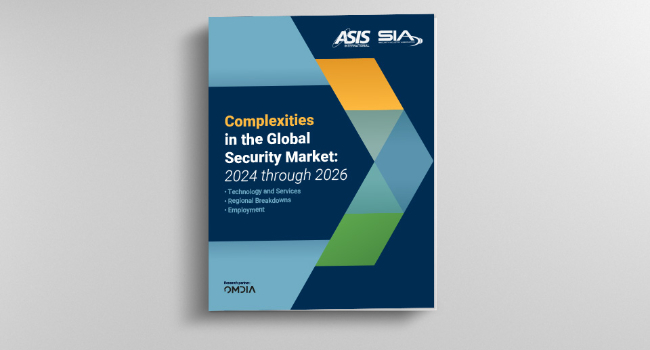
ASIS International and SIA Release “Complexities in the Global Security Market: 2024 Through 2026”
ASIS International and the Security Industry Association (SIA) – the leading security associations for the security industry – have released ”Complexities in the Global Security Market: 2024 Through 2026”, a new research report that provides insights into the equipment, technologies, and employment of the global security industry, including regional market breakouts. SIA and ASIS partnered with global analytics and advisory firm Omdia to complete the research.
This exclusive report – produced for SIA and ASIS members – provides new global market statistics for the security equipment and service markets, including the entire route to market from the equipment and software companies manufacturing the technologies to the service providers deploying them through to the end users using the security and life safety solutions in their daily roles. The publication was designed for practitioners in corporate, organizational and private security roles, as well as security solutions providers and equipment manufacturers, and is also relevant for others interested in the security market, including investors, academics and government officials.
Key research findings include:
- The global physical security equipment market is expected to be worth $60.1 billion in 2024, as the industry continues to recover following the COVID-19 pandemic and grow to $70 billion by 2026.
- The overall physical security equipment and services market is much larger, totaling $405 billion in 2023 and projected to grow to nearly $500 billion by 2026.
- The physical security market employs more than 30 million people worldwide, with 210,000 of those being in the equipment market, about 7.87 million in the services market and 22.6 million working as security end users.
“The Complexities in the Global Security Market report presents critical economic insights on the importance of the global security industry and offers a valuable snapshot of where we are moving over the next three years,” said SIA CEO Don Erickson. “Through a collaborative effort between SIA and ASIS, we are pleased to present new and useful data and trend insights on the direction of the physical security market, employment and the influence of technological change to our members. We hope that our members will leverage this report to shape their future business strategies.”
The report also includes analyses of regional demand, solution requirements, economic conditions, service and equipment preferences, and political challenges, as well as the impact of technology trends like artificial intelligence and cloud computing.
“The industry has long needed a study to understand the scope and breadth of the security sector, which is important economically just as it is vital to ensure we have secure and safe workplaces around the world,” said Peter O’Neil, FASAE, CAE, CEO, ASIS International. “We are proud to have worked with the Security Industry Association on this groundbreaking research. The strength, vitality, and importance of the security industry has never been more apparent.”
The research report can be accessed for free by ASIS and SIA members; it can be found on the ASIS site here and on the SIA site here.